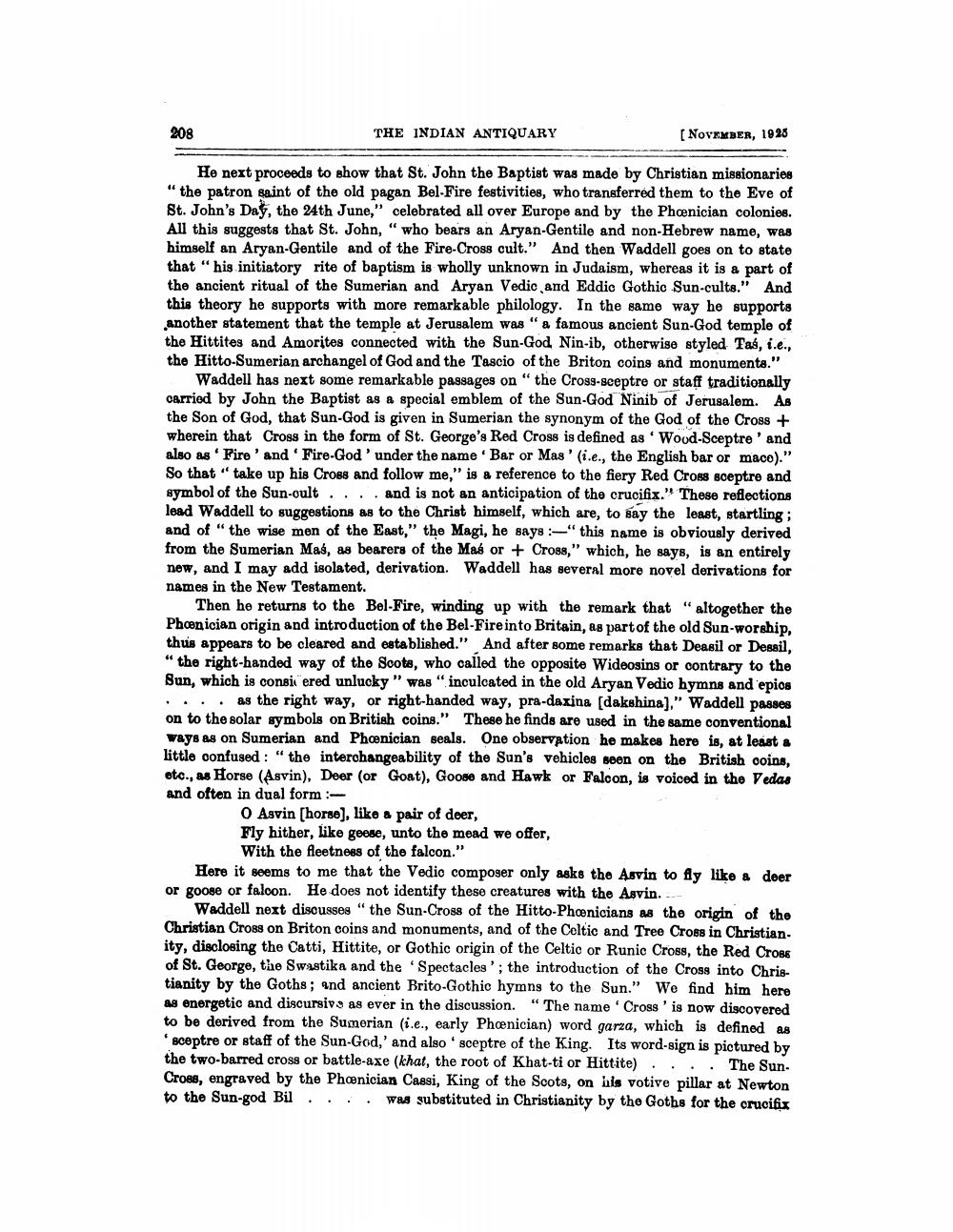________________
208
THE INDIAN ANTIQUARY
He next proceeds to show that St. John the Baptist was made by Christian missionaries "the patron saint of the old pagan Bel-Fire festivities, who transferred them to the Eve of St. John's Day, the 24th June," celebrated all over Europe and by the Phoenician colonies. All this suggests that St. John, "who bears an Aryan-Gentile and non-Hebrew name, was himself an Aryan-Gentile and of the Fire-Cross cult." And then Waddell goes on to state that "his initiatory rite of baptism is wholly unknown in Judaism, whereas it is a part of the ancient ritual of the Sumerian and Aryan Vedic and Eddic Gothic Sun-cults." And this theory he supports with more remarkable philology. In the same way he supports another statement that the temple at Jerusalem was "a famous ancient Sun-God temple of the Hittites and Amorites connected with the Sun-God, Nin-ib, otherwise styled Tas, i.e., the Hitto-Sumerian archangel of God and the Tascio of the Briton coins and monuments."
Waddell has next some remarkable passages on "the Cross-sceptre or staff traditionally carried by John the Baptist as a special emblem of the Sun-God Ninib of Jerusalem. As the Son of God, that Sun-God is given in Sumerian the synonym of the God of the Cross + wherein that Cross in the form of St. George's Red Cross is defined as Wood-Sceptre' and also as 'Fire' and 'Fire-God' under the name Bar or Mas' (i.e., the English bar or mace)." So that" take up his Cross and follow me," is a reference to the fiery Red Cross sceptre and symbol of the Sun-cult. ... and is not an anticipation of the crucifix." These reflections lead Waddell to suggestions as to the Christ himself, which are, to say the least, startling; and of "the wise men of the East," the Magi, he says:-" this name is obviously derived from the Sumerian Mas, as bearers of the Maé or + Cross," which, he says, is an entirely new, and I may add isolated, derivation. Waddell has several more novel derivations for names in the New Testament.
[NOVEMBER, 1925
Then he returns to the Bel-Fire, winding up with the remark that "altogether the Phoenician origin and introduction of the Bel-Fire into Britain, as part of the old Sun-worship, thus appears to be cleared and established." And after some remarks that Deasil or Dessil, "the right-handed way of the Scots, who called the opposite Wideosins or contrary to the Sun, which is consi ered unlucky" was "inculcated in the old Aryan Vedic hymns and epics
... as the right way, or right-handed way, pra-daxina [dakshina]," Waddell passes on to the solar symbols on British coins." These he finds are used in the same conventional ways as on Sumerian and Phoenician seals. One observation he makes here is, at least a little confused: "the interchangeability of the Sun's vehicles seen on the British coins, etc., as Horse (Asvin), Deer (or Goat), Goose and Hawk or Falcon, is voiced in the Vedas and often in dual form :
O Asvin [horse], like a pair of deer,
Fly hither, like geese, unto the mead we offer,
With the fleetness of the falcon."
Here it seems to me that the Vedic composer only asks the Asvin to fly like a deer or goose or falcon. He does not identify these creatures with the Asvin.
Waddell next discusses "the Sun-Cross of the Hitto-Phoenicians as the origin of the Christian Cross on Briton coins and monuments, and of the Celtic and Tree Cross in Christianity, disclosing the Catti, Hittite, or Gothic origin of the Celtic or Runic Cross, the Red Cross of St. George, the Swastika and the 'Spectacles'; the introduction of the Cross into Christianity by the Goths; and ancient Brito-Gothic hymns to the Sun." We find him here as energetic and discursive as ever in the discussion. "The name Cross' is now discovered to be derived from the Sumerian (i.e., early Phoenician) word garza, which is defined as 'sceptre or staff of the Sun-God,' and also sceptre of the King. Its word-sign is pictured by the two-barred cross or battle-axe (khat, the root of Khat-ti or Hittite). ... The SunCross, engraved by the Phoenician Cassi, King of the Scots, on his votive pillar at Newton to the Sun-god Bil was substituted in Christianity by the Goths for the crucifix




